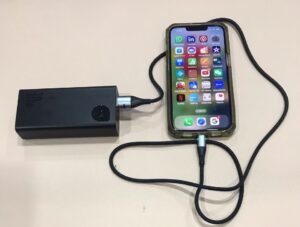
Baseus Power Bank 30W 10,000mAh with iPhone
Understanding what can cause battery explosions in aircraft cabins
The use of rechargeable lithium-ion batteries, such as those found in power banks has become common for providing portable power to electronic devices such as your handphones.
While generally safe, these batteries can pose risks of fire or explosion if they malfunction. It’s crucial to adhere to safety guidelines to prevent incidents.
When traveling, power banks should have a capacity of no more than 100 watt-hours or 20,000 milliamp hours (mAh) and they should be packed securely to prevent damage and accidental activation.
However, regulations may vary by country and airlines. For instance, Chinese airlines enforce stringent safety rules with a cap on 10,000 mAh on power banks.
During my recent trip to Xinjiang, my power bank with only 6200 mAh was confiscated due to a hairline crack on its cover.
After I retired from flying, I conducted classes on fighting lithium battery fires and noted that fighting such fire was unlike battling normal fire, especially when the excessive heat leads to a thermal runaway.
This phenomenon happens when the lithium-ion cell enters into an uncontrollable, self-heating state with extremely high temperatures.
Surprisingly, water is less effective in bringing down the temperature because thermal runaway keeps releasing more energy and raising the temperature again, causing a chain reaction, leading to ferocious flames sometimes seen in electric vehicles (EVs) fire.
Only BCF (bromochlorodifluoromethane) or Halon Fire extinguishers on planes are most effective in fighting lithium battery fire.
Despite safety precautions on rechargeable batteries, incidents involving power banks are on the rise.
Recent events include a Thai AirAsia, a Singapore’s low-cost carrier Scoot and a Russian Ural Airlines flight where power banks on board the flights had caused smoke and fire. (See the 2 videos in comments below)
Thankfully, all these incidents were handled safely by the cabin crew but a poorly managed fire can quickly escalate and can turn your flight into a death trap within minutes.
The importance of adhering to safety guidelines is highlighted by historical tragedies such as the 1980 Saudi Arabian Airlines TriStar jet incident where toxic fumes from an uncontrolled fire led to the loss of all 301 passengers and crew lives even after a safe landing.
To mitigate risks, strict guidelines for traveling with power banks are established.
Remember, these devices must be below 20,000 mAh or 100 watt-hours and should only be packed in carry-on baggage and not in checked baggage.
Why not allowed on checked-in baggage?
Power bank has metal inside and may be unstable. It can cause friction during transportation and catches fire when it generates high temperature.
As such, having them in carry-on baggage is within easy reach to fight the fire but not when they are inside checked-in baggage.
Wishing you all a safe flight!
See YouTube video ‘Chaos Erupts Mid Air After Power Bank Exploded In Airasia Flight’
here https://www.youtube.com/watch?v=FHBZwqGkDjw
See YouTube video ‘A power bank caught fire on a Scoot flight from Taipei to Singapore shortly before its take-off’
here https://www.youtube.com/watch?v=SAHGV_x-fnM
See a YouTube video ‘Explosions in the Sky: Lithium-ion Battery Fires in Flight’
here https://www.youtube.com/watch?v=-E3nOo2h0Xs